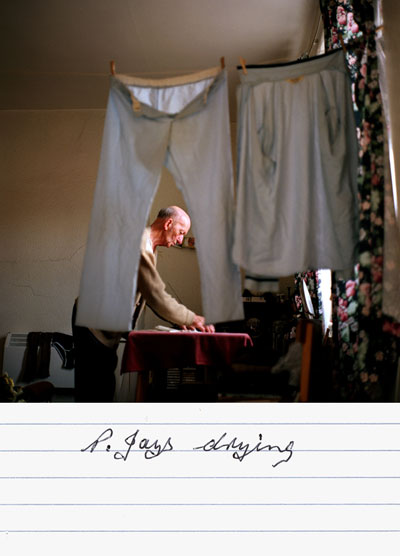A Day in the Life
KayLynn Deveney photographs the comings and goings of a man in Wales, drawing out moments of repose and oddness from the humdrum.

Interview by Rosecrans Baldwin
How did you first come to know Albert Hastings? What drew you to photographing his activities?
We lived in the same neighborhood in southern Wales. My husband and I had both noticed Bert outside his building, sometimes watching the world go by, sometimes watering the garden. Because there was no garden hose, Bert watered by filling empty dishwashing liquid bottles. That action seemed so caring. In my eyes, Bert contrasted with the decaying old building that housed his flat. He seemed vital, engaged, and interesting. I wanted to meet him, and finally, one day I walked over and introduced myself. That was the beginning. Continue reading ↓
Some of KayLynn Deveney’s photos from The Day-to-Day Life of Albert Hastings will appear in the show “Relative Closeness” at Chicago’s Museum of Contemporary Photography, June 15–Aug. 4, 2007. All images courtesy Princeton Architectural Press. All images copyright © KayLynn Deveney, all rights reserved.


















Interview continued
Over how long a period did you know Bert? For how long did you photograph him?
I met Bert in Spring 2001 and I began photographing him very shortly after. I photographed Bert extensively in 2001 and 2002. In June 2002 I moved back to the United States permanently, so, after that, I photographed Bert only on my visits back to Wales. I was in touch with him until he passed away in February 2007.
Knowing the lens was trained on him, do you think his behavior changed?
I can’t imagine that anyone would be able to act completely naturally while they were being photographed. However, I think Bert was quite unselfconscious and trusting. I think too that the quantity of time we spent together—with me photographing—probably helped both of us get used to my being there with a camera.
How would you feel if the tables were reversed, if Bert was taking pictures of you?
Probably very self-conscious. I have never had someone follow me around the way I follow the people I photograph. I imagine it is difficult. However, I think I would be glad for the opportunity to comment on the way I was depicted.
The book becomes so moving with those captions. Whose idea was it for Bert to write them?
Early on, Bert made some very intriguing comments about the photographs I had made of him. I was so interested in what he had to say about the images. Additionally, I was interested in experimenting with the traditional photographer/subject relationship by allowing the person depicted in the photographs an opportunity to publicly respond to the image. So I asked Bert to caption small prints I kept in a pocket-sized notebook.
Would you consider this book to be a biography in some way of Bert’s life?
Not really. I think of this work more as a collection of reflections on Bert that are seen first through the subjective eyes of a foreign photographer and then by the subject himself. I am very careful to point out that I do not believe there is a single “true” or definitive story about Bert or, indeed, any one of us. Our stories vary depending on the storyteller and how he or she perceives us, and they are always incomplete.
Do you have any favorite memories of Bert that weren’t depicted in the book?
I have many great memories of Bert. He often cracked me up, and I have many memories of laughing hard at something he said. One nice memory in particular, though, is the time Bert sewed my sandals for me so that I could keep wearing them. He was good at solving problems.
What are you working on now?
I am writing my dissertation. I am a Ph.D. student in photographic studies at the University of Wales at Newport. My dissertation focuses on a selection of historical and contemporary photographic diaries and the way these autobiographical books address and challenge our common notions about domestic life.
